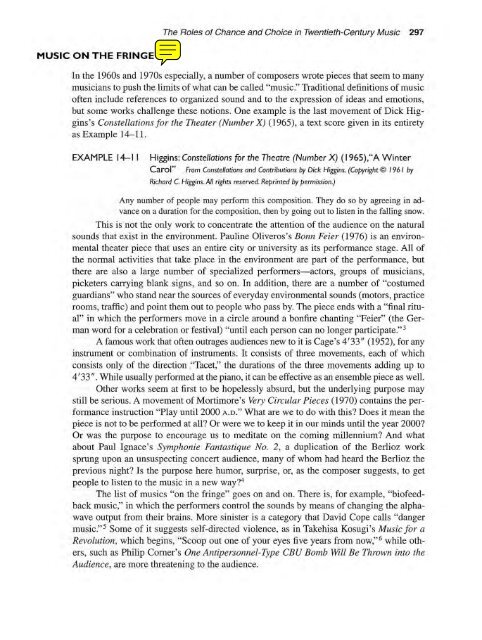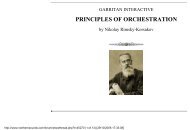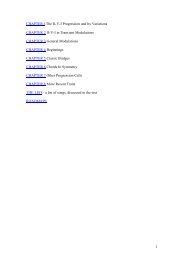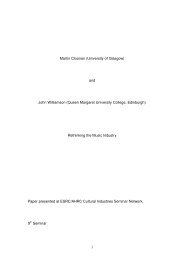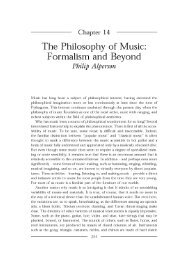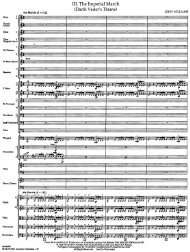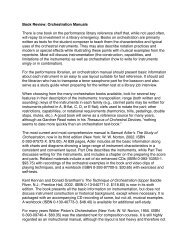TWENTIETH- - Synapse Music
TWENTIETH- - Synapse Music
TWENTIETH- - Synapse Music
You also want an ePaper? Increase the reach of your titles
YUMPU automatically turns print PDFs into web optimized ePapers that Google loves.
MUSIC ON THE FRINGE<br />
The Roles of Chance and Choice in Twentieth-Century <strong>Music</strong> 297<br />
In the 1960s and 1970$ especially, a number of composers wrote pieces that seem to many<br />
musicians to push the limits of what can be called "music." Traditional definitions of music<br />
often include references to organized sound and to the expression of ideas and emotions,<br />
but some works challenge these notions. One example is the last movement of Dick Hig·<br />
gins's COllslellatioll .. '>jor the Theater (Number X) (1965), a text score given in its entirety<br />
as Example 14- 11.<br />
EXAMPLE 14-1 1 Higgins: Constellations for the Theatre (Number X) ( 196S),"A Winter<br />
Carol" From Cons!ellations and Contributions by Dick Higgins. (Copyright © 1961 by<br />
Richard C. Higgins. All rights reserved. Reprinted by permission.)<br />
Any number of people may perfonn this composition. They do so by agreeing in advance<br />
on a duration for the composition, then by going out to lislen in the falling snow.<br />
This is not the only work to concentrate the attention of the audience on the natural<br />
sounds that exist in the environment. Pauline Oliveros's Bonn Feier (1976) is an environmental<br />
theater piece that uses an entire city or university as its perfonnance stage. All of<br />
the normal activities that take place in the environment are part of the performance, but<br />
there are also a large number of specialized perfonners-actors, groups of musicians,<br />
picketers carrying blank signs, and so on. In addition, there are a number of "costumed<br />
guardians" who stand near the sources of everyday environmental sounds (motors, practice<br />
rooms, traffic) and point them out to people who pass by. The piece ends with a "final ritual"<br />
in which the performers move in a circle around a bonfire chanting "Feier" (the German<br />
word for a celebration or festival) "until each person can no longer participate."]<br />
A famous work that often outrages audiences new to it is Cage's 4'33" (1952), for any<br />
instrument or combination of instruments. It consists of three movements, each of which<br />
consists only of the direction ,"Tacet," the durations of the three movements adding up to<br />
4'33". While usually performed at the piano, it can be effective as an ensemble piece as well.<br />
Other works seem at first to be hopelessly absurd, but the underlying purpose may<br />
still be serious. A movement of Mortimore's Very Circular Pieces (1970) contains the performance<br />
instruction "Play until 2000 A.D." What are we to do with this? Does it mean the<br />
piece is not to be perfonned at all? Or were we to keep it in our minds until the year 2ooo?<br />
Or was the purpose to encourage us to meditate on the coming millennium? And what<br />
about Paul Ignace's Symphonie Fantastique No.2, a duplication of the Berlioz work<br />
sprung upon an unsuspecting concert audience, many of whom had heard the Berlioz the<br />
previous night? Is the purpose here humor, surprise, or, as the composer suggests, to get<br />
people to li sten to the music in a new way?4<br />
The list of musics "on the fringe" goes on and on. There is, for example, "biofeedback<br />
music," in which the performers control the sounds by means of changing the alphawave<br />
output from their brains. More sinister is a category that David Cope calls "danger<br />
music.',j Some of it suggests self-directed violence, as in Takehisa Kosugi's <strong>Music</strong> for a<br />
Revolution, which begins, "Scoop out one of your eyes five years from now," 6 while others,<br />
such as Philip Comer's One Antipersonnel-Type CBU Bomb Will Be Thrown into the<br />
Audience, are more threatening to the audience.


